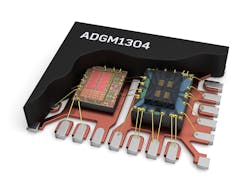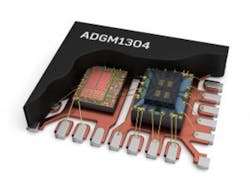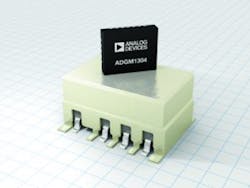Analog Devices debuts RF MEMS switches at electronica
Analog Devices today at electronica 2016 in Munich introduced new RF-MEMS switch technology. With the commercial release of products enabled by this technology, OEMs can improve the accuracy and versatility of ATE and other instrumentation tools to help their customers reduce testing costs, power, and time to market. Future products within the MEMS switch series will replace relays in aerospace and defense, healthcare, and communications infrastructure equipment.
Initial MEMS switch products using the technology include the ADGM1304 SP4T 0-Hz (DC) to 14-GHz switches, which have applicability in network and spectrum analyzers as well as oscilloscopes and AWGs.
In a phone interview last week, Ray Goggin, product line manager for switches, multiplexers, voltage references, said the new MEMS switches represent the latest initiative in ADI’s MEMS technology extending back to 1991, when the company introduced its first accelerometer for airbag deployment using ADI’s proprietary iMEMS process. To date, he said, the company has shipped more than 1 billion inertial sensors for automotive, industrial, and consumer applications. The MEMS switches, he added, represent a new category for the company.
Each of the new switches, he said, comes in a 5-mm x 4-mm x 0.95-mm QFN package. Features include a five-contact gold-beam electrostatically actuated cantilever switch design with metal-hardened contacts. The switch is co-packaged with a high-voltage, low-power drive IC.
The switch offers an on-resistance of less than 2 Ω and off leakage current of 0.5 nA. Total harmonic distortion (THD+N) is -110 dBc. Goggin said that for future implementations these specs can be improved through beam and substrate optimization. Third-order intermodulation intercept is 69 dBm over the full frequency range of operation—this performance can potentially be increased beyond 75 dBm. RF power handling is 40 dBm over the full frequency range, with 200 mA of DC current handling per switch. The switches are guaranteed for 1 billion actuation cycles; Goggin said the company has demonstrated levels well beyond the 1 billion number.
Goggin cited a critical figure of merit for switch technology: on resistance multiplied by off capacitance, or RonCoff. “As RonCoff reduces, the insertion loss of the switch also reduces, and the off isolation improves,” he said. “The ADI switch technology RonCoff product for a single switch unit is < 8, guaranteeing its position as the technology of choice to enable world-class switch performance.”
Goggin cited several test-and-measurement instrumentation applications for the MEMS switches, including the filter-bank switching needed for wideband instruments where different frequency bands are implemented using different RF architectures. They can also be used for attenuator switching to improve dynamic range or for channel multiplexing.
The MEMS switches, he said, offer the opportunity to consider new instrument architectures—involving, for example, a low-loss multi-throw frontend or zero IF architecture with mixing stages removed. He also cited ATE applications, including general digital and RF signal routing on load boards. A key benefit, he said, includes a 90% area savings compared with a DPDT electromechanical relay.
In addition to test and measurement, Goggin said, the MEMS switches can serve in aerospace/defense, healthcare, and consumer and communications applications spanning 5G, IoT, and WiGig (802.11ad). In conclusion, he said, the new MEMS switch line complements the company’s line of analog, SOI, and GaAs switch offerings.
The first in a new product series, ADI’s ADGM1304 and ADGM1004 RF MEMS switches are 95% smaller, 30 times faster, 10 times more reliable, and use 10 times less power than conventional electromechanical relays. The ADGM1004 operates to 13 GHz and offers 2.5-kV HBM ESD protection.
Unlike other switch alternatives such as solid-state relays, the ADGM1304 and ADGM1004 MEMS switches have superior precision and RF performance from 0 Hz (DC) to 14 GHz. ADI’s MEMS switch solution contains two die to maximize operational performance—an electrostatically actuated switch in a hermetically sealed silicon cap, and a low-voltage, low-current driver IC. The switching element has a highly conditioned, extremely reliable metal-to-metal contact that is actuated via an electrostatic force generated by the companion driver IC. The resultant co-packaged solution ensures best-in-class DC precision and RF performance, and makes the switch extremely easy to use.
The highly reliable ADGM1304 and ADGM1004 increase cold-switching lifetime by a factor of 10 compared to electromechanical relays, extending ATE system operating life and reducing costly downtime caused by relay failures. Additionally, the extremely small height of the ADGM1304 and ADGM1004 MEMS switch packages allow designers to surface-mount the devices on both sides of their ATE test boards to boost channel densities at reduced cost and without expanding equipment footprint. An integrated charge pump removes the need for external drivers, further reducing ATE system size, while a multiplexer configuration simplifies the fan-out structure compared with DPDT relay designs.
Prices start at $36.58 each in quantities of 1,000.
Learn more about ADI’s MEMS switch technology at http://www.analog.com/memsswitch.
View the ADGM1304 and ADGM1004 MEMS switch product pages, download data sheets, and order samples and evaluation boards at
About the Author

Rick Nelson
Contributing Editor
Rick is currently Contributing Technical Editor. He was Executive Editor for EE in 2011-2018. Previously he served on several publications, including EDN and Vision Systems Design, and has received awards for signed editorials from the American Society of Business Publication Editors. He began as a design engineer at General Electric and Litton Industries and earned a BSEE degree from Penn State.



